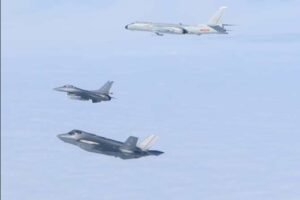
The Arctic strategic environment is changing profoundly, and the United States must pay greater attention and dedicate more resources to this crucial area, said Iris A. Ferguson, the deputy assistant secretary of defense for Arctic and Global Resilience.
Ferguson addressed the increased attention that the People’s Republic of China has in the Arctic. She spoke at the Center for Strategic and International Studies today.
China is, by no means, an Arctic nation. But Chinese leaders see the region as a new crossroads of the world, a new source of raw materials and new avenues for manifesting its growing power.
China is working closely with Russia in its attempt to be seen as an Arctic power, Ferguson said. Even with Russia’s unjust war on Ukraine, President Vladimir Putin is investing heavily on military and economic strategies in the Arctic. “We’re seeing Russia continue to have immense focus on the Arctic region, and it’s part of their … security calculus, vis-a-vis the U.S. and NATO,” Ferguson said. “Despite the attrition in Ukraine, we still see them … heavily focused on the region.”
A shifting climate is speeding the pace of change in the region. “Climate change is still a factor in the region, where the region warms at some four times the rate of the rest of the world,” she said. This means more access for settlements in the high North and more chances for what she calls “competitor activity.”
“[China] is one of the newer entrants on the scene,” Ferguson said. “Over time, the strategic interests that they have in the region are … giving us pause. How their long-term vision for the region could affect our interests, is [also] giving us pause.”
Even more disturbing is the increasing levels of collaboration between Russia and China especially in the military domain, she said. Russia and China exercised together in the Bering Strait in summer of 2023. “Just this past summer, right after we released our department [Arctic] strategy, we saw a joint bomber patrol off of the coast of Alaska.”
There has also been increasing cooperation between the Chinese and Russian coast guards in the region. “This kind of increasing levels of military cooperation is new,” she said. “Certainly, it’s new within and around Alaska.”
The new DOD Arctic strategy is aimed at preserving the region as a place that is both stable and secure, Ferguson said. She also discussed the Defense Department’s three main lines of effort in the region. The first is enhancing domain awareness to see and detect threats, and to ensure U.S. forces can operate in the region effectively.
“We’re also really focused on engaging with our allies and partners,” she said. These nations are a unique U.S. strategic advantage that stretches from the border of European Russia to the Bering Strait. These are “seven like-minded partners that are incredibly militarily capable and also have heavy geostrategic alignment with us,” she said.
Finally, the United States is working on using military exercises in the region. “We’ve long had exercises that operate in the region, but we’re really looking at how we can use those as a deterrent effect, working alongside our allies and partners,” she said.
There’s an evolution in how competitors think about the region, Ferguson said. “We’re going to continue on the DOD side to monitor military activity.”
But this attention cannot be just limited to that. The Chinese are using other aspects of their national power to insinuate themselves into the region. China is involved in scientific and research projects in the region. China is looking to establish economic ties within the Arctic. “We really just need to be clear-eyed about some of their intentions and, how we can be like thinking about their long-term interests and, how we can best protect ours,” Ferguson said.
[content id=”79272″]






